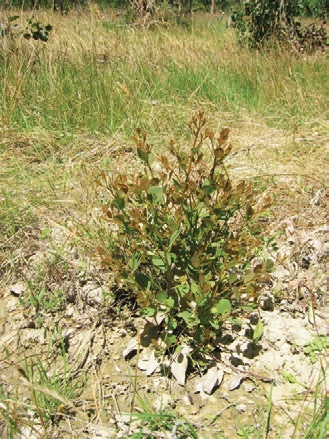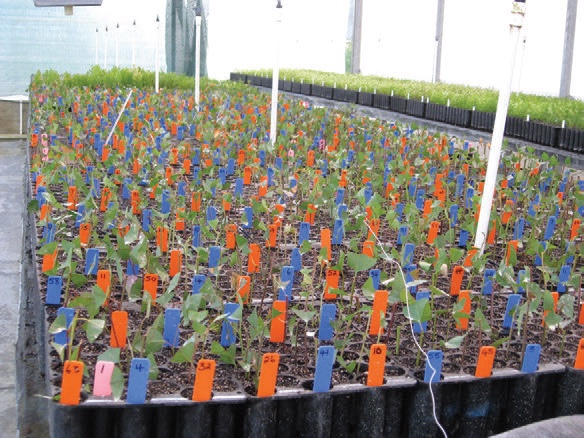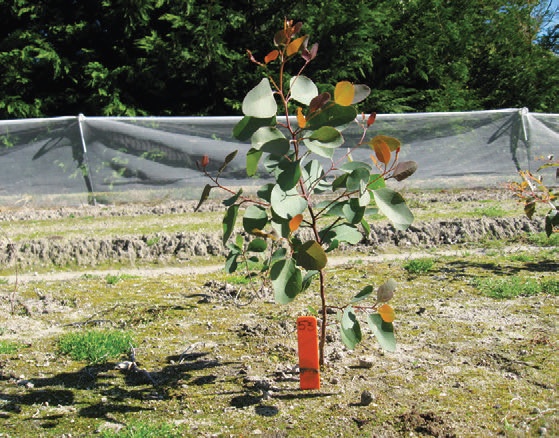Propagating ground-durable eucalypts using cuttings from coppice
Mike Menzies, Mike Dibley, Charlie Low and Ruth McConnochie, New Zealand Tree Grower November 2012.
The Future Forests Research Diversified Species Programme has a number of projects aimed at improving the supply of quality planting stock for growers. Species involved include redwoods, cypress, indigenous species and eucalypts. This article concerns work to boost the availability of clonal material from two ground durable eucalypt species.
Eucalyptus bosistoana and E. globoidea are ground durable species. They are among the current favourites being trialled by the Dryland Forests Initiative with the aim of identifying species which have the most potential for use as fencing and vineyard posts without the need for any chemical treatment, as is required for radiata pine.
Both the above named species regrow from cut stumps or coppice. If cuttings taken from coppice shoots can be successfully rooted, growers will have a source of clonal planting material from selected trees. Scion researchers have recently completed an experiment to investigate whether cuttings from both these eucalyptus species will root. The results have been promising.
Obtaining the cuttings
Thirty trees of each of E. bosistoana and E. globoidea, being grown in ground-durable species trials near Blenheim, were felled in November 2010. The E. bosistoana consisted of a range of clones, while the E. globoidea included clones of three different kinds. Coppice regrowth on the cut stumps was cut back in January 2011 to encourage more sprouting close to the cut stump, and then cuttings were taken from stump regrowth in April 2011.
Setting the cuttings

The coppice shoots were trimmed into cuttings between 100 and 120 millimetres long, and prepared for setting as follows −
- Selected cuttings had diameters between two and four millimetres
- The base of each cutting was directly below a leaf node
- Cuttings included one to two whorls of leaves
- Leaves were trimmed to about half size to reduce transpiration.
Each cutting was dipped in a rooting hormone. Two rooting hormones were used for comparison – a gel Clonex, 0.3 per cent IBA hormone, and a powder one per cent IBA hormone. The rooting medium was a fine peat, pumice, perlite mix with five kilograms of slow release fertiliser for each cubic metre of medium.
The set cuttings were placed on a heated bench between 18°C and 22 °C in a temperature-controlled greenhouse at 90 per cent relative humidity and with a 16-hour photoperiod. After seven months, the trials were assessed with the results given in the table.
Summary
These initial results have been very encouraging. Rooted cuttings from all the available clones have been set out in the Scion nursery to be managed as stool plants for the further production of cutting material.
| Successful rooting | Cutting stem diameter | Rooting agent, gel or powder? | Clonal variation | |
|---|---|---|---|---|
| E. bosistoana | 21 per cent | Small diameter gave better results | Powder gave better results | Some clones markedly better than others |
| E. globoidea | 50 per cent | Small diameter gave better results | No difference between agents | Less difference between clones |
Researchers want to find out more about how the cutting size affects rooting success, whether the timing of setting is important, and whether stool plants can be managed for several years without maturation causing problems. Field trials may follow, and eventually scientists hope to have a series of recommendations for growers on propagating eucalypts from coppice shoot cuttings.
Mike Menzies, Mike Dibley, and Charlie Low all work for Scion and Ruth McConnochie is with the NZ Dryland Forests Initiative



 Farm Forestry New Zealand
Farm Forestry New Zealand